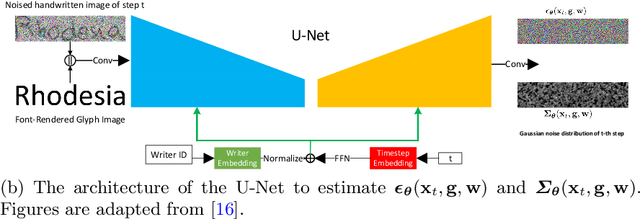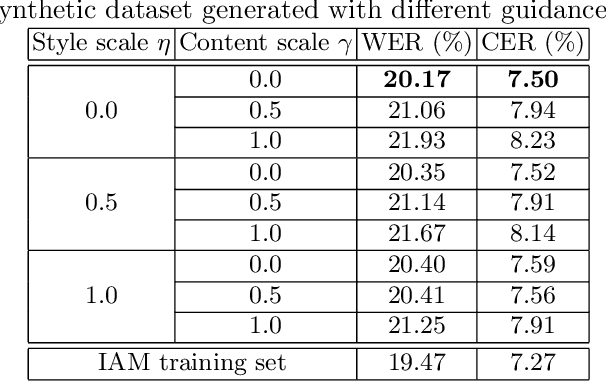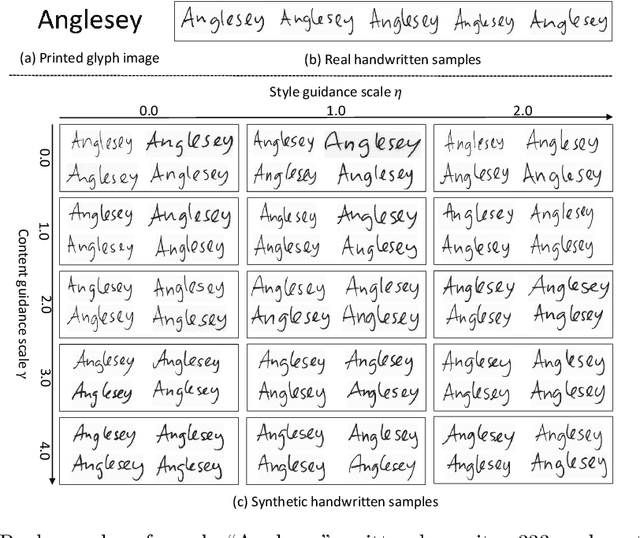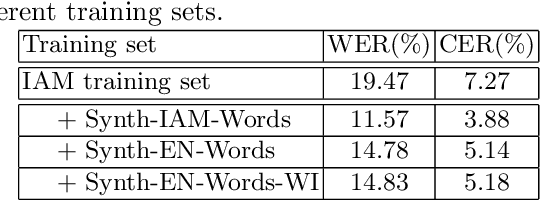Haisong Ding
Improving Handwritten OCR with Training Samples Generated by Glyph Conditional Denoising Diffusion Probabilistic Model
May 31, 2023



Abstract:Constructing a highly accurate handwritten OCR system requires large amounts of representative training data, which is both time-consuming and expensive to collect. To mitigate the issue, we propose a denoising diffusion probabilistic model (DDPM) to generate training samples. This model conditions on a printed glyph image and creates mappings between printed characters and handwritten images, thus enabling the generation of photo-realistic handwritten samples with diverse styles and unseen text contents. However, the text contents in synthetic images are not always consistent with the glyph conditional images, leading to unreliable labels of synthetic samples. To address this issue, we further propose a progressive data filtering strategy to add those samples with a high confidence of correctness to the training set. Experimental results on IAM benchmark task show that OCR model trained with augmented DDPM-synthesized training samples can achieve about 45% relative word error rate reduction compared with the one trained on real data only.
GlyphControl: Glyph Conditional Control for Visual Text Generation
May 29, 2023



Abstract:Recently, there has been a growing interest in developing diffusion-based text-to-image generative models capable of generating coherent and well-formed visual text. In this paper, we propose a novel and efficient approach called GlyphControl to address this task. Unlike existing methods that rely on character-aware text encoders like ByT5 and require retraining of text-to-image models, our approach leverages additional glyph conditional information to enhance the performance of the off-the-shelf Stable-Diffusion model in generating accurate visual text. By incorporating glyph instructions, users can customize the content, location, and size of the generated text according to their specific requirements. To facilitate further research in visual text generation, we construct a training benchmark dataset called LAION-Glyph. We evaluate the effectiveness of our approach by measuring OCR-based metrics and CLIP scores of the generated visual text. Our empirical evaluations demonstrate that GlyphControl outperforms the recent DeepFloyd IF approach in terms of OCR accuracy and CLIP scores, highlighting the efficacy of our method.
Zero-shot Generation of Training Data with Denoising Diffusion Probabilistic Model for Handwritten Chinese Character Recognition
May 25, 2023



Abstract:There are more than 80,000 character categories in Chinese while most of them are rarely used. To build a high performance handwritten Chinese character recognition (HCCR) system supporting the full character set with a traditional approach, many training samples need be collected for each character category, which is both time-consuming and expensive. In this paper, we propose a novel approach to transforming Chinese character glyph images generated from font libraries to handwritten ones with a denoising diffusion probabilistic model (DDPM). Training from handwritten samples of a small character set, the DDPM is capable of mapping printed strokes to handwritten ones, which makes it possible to generate photo-realistic and diverse style handwritten samples of unseen character categories. Combining DDPM-synthesized samples of unseen categories with real samples of other categories, we can build an HCCR system to support the full character set. Experimental results on CASIA-HWDB dataset with 3,755 character categories show that the HCCR systems trained with synthetic samples perform similarly with the one trained with real samples in terms of recognition accuracy. The proposed method has the potential to address HCCR with a larger vocabulary.
APRNet: Attention-based Pixel-wise Rendering Network for Photo-Realistic Text Image Generation
Mar 15, 2022



Abstract:Style-guided text image generation tries to synthesize text image by imitating reference image's appearance while keeping text content unaltered. The text image appearance includes many aspects. In this paper, we focus on transferring style image's background and foreground color patterns to the content image to generate photo-realistic text image. To achieve this goal, we propose 1) a content-style cross attention based pixel sampling approach to roughly mimicking the style text image's background; 2) a pixel-wise style modulation technique to transfer varying color patterns of the style image to the content image spatial-adaptively; 3) a cross attention based multi-scale style fusion approach to solving text foreground misalignment issue between style and content images; 4) an image patch shuffling strategy to create style, content and ground truth image tuples for training. Experimental results on Chinese handwriting text image synthesis with SCUT-HCCDoc and CASIA-OLHWDB datasets demonstrate that the proposed method can improve the quality of synthetic text images and make them more photo-realistic.
 Add to Chrome
Add to Chrome Add to Firefox
Add to Firefox Add to Edge
Add to Edge